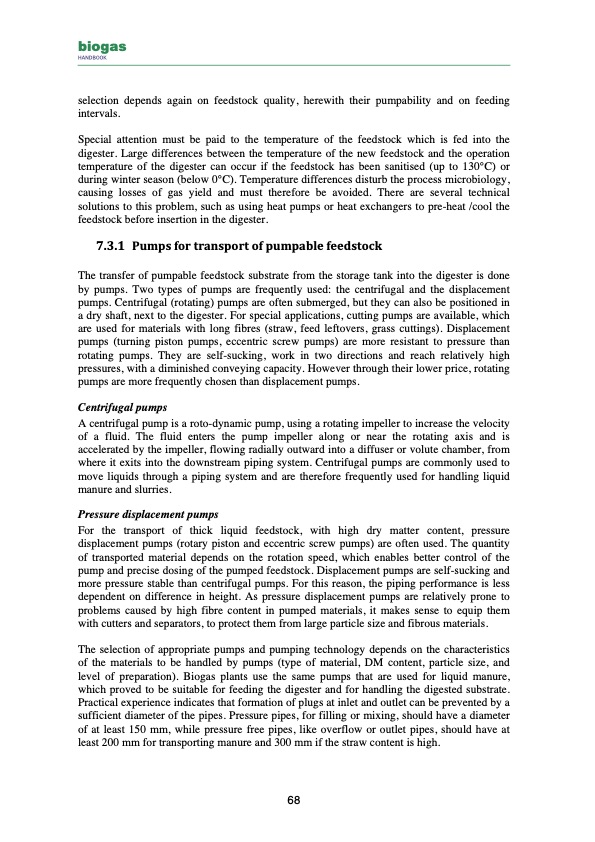
PDF Publication Title:
Text from PDF Page: 068
biogas HANDBOOK selection depends again on feedstock quality, herewith their pumpability and on feeding intervals. Special attention must be paid to the temperature of the feedstock which is fed into the digester. Large differences between the temperature of the new feedstock and the operation temperature of the digester can occur if the feedstock has been sanitised (up to 130°C) or during winter season (below 0°C). Temperature differences disturb the process microbiology, causing losses of gas yield and must therefore be avoided. There are several technical solutions to this problem, such as using heat pumps or heat exchangers to pre-heat /cool the feedstock before insertion in the digester. 7.3.1 Pumpsfortransportofpumpablefeedstock The transfer of pumpable feedstock substrate from the storage tank into the digester is done by pumps. Two types of pumps are frequently used: the centrifugal and the displacement pumps. Centrifugal (rotating) pumps are often submerged, but they can also be positioned in a dry shaft, next to the digester. For special applications, cutting pumps are available, which are used for materials with long fibres (straw, feed leftovers, grass cuttings). Displacement pumps (turning piston pumps, eccentric screw pumps) are more resistant to pressure than rotating pumps. They are self-sucking, work in two directions and reach relatively high pressures, with a diminished conveying capacity. However through their lower price, rotating pumps are more frequently chosen than displacement pumps. Centrifugal pumps A centrifugal pump is a roto-dynamic pump, using a rotating impeller to increase the velocity of a fluid. The fluid enters the pump impeller along or near the rotating axis and is accelerated by the impeller, flowing radially outward into a diffuser or volute chamber, from where it exits into the downstream piping system. Centrifugal pumps are commonly used to move liquids through a piping system and are therefore frequently used for handling liquid manure and slurries. Pressure displacement pumps For the transport of thick liquid feedstock, with high dry matter content, pressure displacement pumps (rotary piston and eccentric screw pumps) are often used. The quantity of transported material depends on the rotation speed, which enables better control of the pump and precise dosing of the pumped feedstock. Displacement pumps are self-sucking and more pressure stable than centrifugal pumps. For this reason, the piping performance is less dependent on difference in height. As pressure displacement pumps are relatively prone to problems caused by high fibre content in pumped materials, it makes sense to equip them with cutters and separators, to protect them from large particle size and fibrous materials. The selection of appropriate pumps and pumping technology depends on the characteristics of the materials to be handled by pumps (type of material, DM content, particle size, and level of preparation). Biogas plants use the same pumps that are used for liquid manure, which proved to be suitable for feeding the digester and for handling the digested substrate. Practical experience indicates that formation of plugs at inlet and outlet can be prevented by a sufficient diameter of the pipes. Pressure pipes, for filling or mixing, should have a diameter of at least 150 mm, while pressure free pipes, like overflow or outlet pipes, should have at least 200 mm for transporting manure and 300 mm if the straw content is high. 68PDF Image | biogas HANDBOOK

PDF Search Title:
biogas HANDBOOKOriginal File Name Searched:
BiogasHandbook.pdfDIY PDF Search: Google It | Yahoo | Bing
Capstone Turbine and Microturbine: Capstone microturbines used and new surplus for sale listing More Info
Consulting and Strategy Services: Need help with Capstone Turbine, sizing systems, applications, or renewable energy strategy, we are here to assist More Info
Container Lumber Dry Kiln: Since 1991 developing and innovating dry kilns using standard shipping containers More Info
Supercritical CO2 Lumber Dry Kiln: Compact fast drying in 3 days or less for small amounts of wood and lumber drying More Info
BitCoin Mining: Bitcoin Mining and Cryptocurrency... More Info
Publications: Capstone Turbine publications for microturbine and distributed energy More Info
FileMaker Software for Renewable Energy Developing database software for the renewable energy industry More Info
CO2 Gas to Liquids On-Demand Production Cart Developing a supercritical CO2 to alcohol on-demand production system (via Nafion reverse fuel cell) More Info
Stranded Gas for low cost power Bitcoin Mining Using stranded gas for generators may provide breakthrough low power costs for cryptocurrency miners. More Info
| CONTACT TEL: 608-238-6001 Email: greg@globalmicroturbine.com | RSS | AMP |